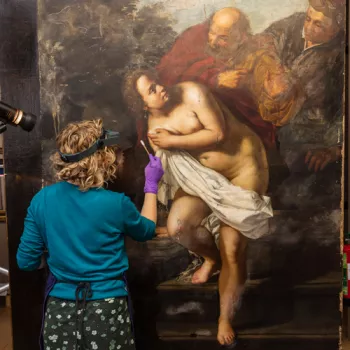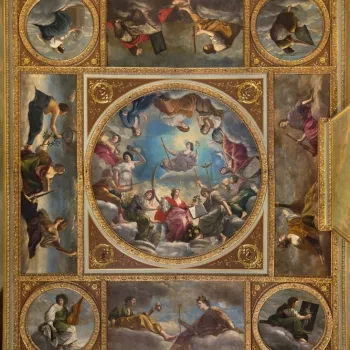Lost Artemisia Gentileschi painting rediscovered in the Royal Collection
Release date: Sunday 24 September 2023
A rare surviving painting by Artemisia Gentileschi, the greatest female artist of her generation, has been rediscovered in the Royal Collection after being misattributed at least two centuries ago.
The rediscovered painting, Susanna and the Elders, forms a significant addition to Artemisia’s extant body of work and sheds fresh light on her creative process and her time in London in the late 1630s, working alongside her father at the court of Charles I and Henrietta Maria.
Following extensive conservation, the painting has now gone on display for visitors to Windsor Castle. Shown alongside it are Self-Portrait as the Allegory of Painting (‘La Pittura’), considered one of Artemisia’s greatest works, and Joseph and Potiphar’s Wife by her father Orazio Gentileschi, painted during his time in London. The three paintings form a new temporary display in the Queen’s Drawing Room, taking their place alongside other Stuart masterpieces in the Royal Collection.
The rediscovery resulted from work by Royal Collection Trust curators, notably former staff member and art historian Dr Niko Munz, to trace the paintings sold off and scattered across Europe after Charles I’s execution. Seven paintings by Artemisia were recorded in Charles I’s inventories but only the Self-Portrait was thought to survive today, with the others thought lost. However, research allowed curators to match the description of Susanna and the Elders to a painting that had been in store at Hampton Court Palace for over 100 years, attributed to ‘French School’ and in very poor condition. A ‘CR’ (‘Carolus Rex’) brand has subsequently been found on the back of the canvas during conservation treatment, confirming that the painting was once in Charles I’s collection.
Conservation work also included the painstaking removal of centuries of surface dirt, discoloured varnish and non-original paint layers to reveal the original composition; removing canvas strips that were added to enlarge the painting sometime after its creation; relining the canvas; retouching old damages; and commissioning a new frame.
Artemisia Gentileschi gained fame across Europe in the 17th century, a time when few women artists were formally recognised. She trained with her father in Rome and later worked in Florence, Naples, Venice and London for aristocratic and royal patrons. Her work fell out of favour in the 18th and 19th centuries, but in the last 50 years she has become known for her powerful and empathetic depictions of women from history.
Find out more about Artemisia Gentileschi's life and art, and watch our film to learn how the work was rediscovered and hear about the extensive conservation work the painting has undergone.











